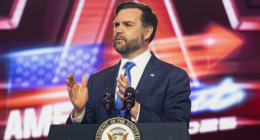Share this @internewscast.com
President Donald Trump speaks before a lunch with Ukraine”s President Volodymyr Zelenskyy in the Cabinet Room of the White House, Friday, Oct. 17, 2025, in Washington (AP Photo/Alex Brandon).
On Friday, a federal judge in San Francisco criticized the Trump administration for disregarding a restraining order that prevents the government from executing planned layoffs amid the government shutdown.
U.S. District Judge Susan Illston, appointed by Bill Clinton, expressed her frustration for the second time in a week at the U.S. Department of Justice lawyers over proposed reductions in force (RIFs), which aim to cut down on federal staff numbers.
The RIFs were initially suggested last month before the shutdown began, as highlighted by the plaintiffs in their 31-page complaint submitted on September 30 in the Northern District of California.
Friday’s session was an emergency hearing, urgently requested by the plaintiffs and convened by the judge after allegations surfaced that the government planned to breach an earlier restraining order that halted these layoffs.
During the proceedings, an attorney representing the American Federation of Government Employees, which advocates for thousands of federal workers across numerous agencies, argued that the Trump administration was misinterpreting the temporary restraining order (TRO).
According to a courtroom report by Federal News Network, a Washington, D.C. radio station, lawyer Danielle Leonard stated, “We believe they are narrowly interpreting the TRO’s scope and overlooking some of its language. The TRO mentions ‘bargaining units or members’ for a reason. Unions represent members whether or not they belong to bargaining units, including at agencies like HHS, where the government has attempted to strip their right to form such units.”
To hear the government tell it, President Donald Trump’s executive order-based efforts to end collective bargaining rights for thousands of federal employees in “national security”-adjacent jobs necessarily limited the reach of the court’s order in the present case.
On Friday, the Department of Health and Human Services (HHS) filed a declaration with the court expressing its intent to comply with the TRO – saying the agency believed recent anti-union efforts meant no-longer-recognized unions would not be covered by the anti-RIF order.
Not so, said the plaintiffs.
And the judge agreed with the unions.
“If an individual person is an employee of the defendant agencies and is a member of a plaintiff union…they can’t be RIFed,” Illston said on Friday. “That’s what I thought I said and what I’m trying to say. That would be contrary to what HHS perhaps thought I meant, but that’s what I do mean.”
Still, in an effort for increased clarity – and for increased labor force protections – the court formally expanded the TRO to cover employees represented by the National Federation of Federal Employees, the Service Employees International Union, and the National Association of Government Employees. Before Friday, the order expressly covered members of the AFGE and the American Federation of State, County And Municipal Employees.
The hearing owed its genesis to claims that the Department of the Interior (DOI) intended to carry out a substantial number of RIFs on Monday, Oct. 20. In their own declaration, DOI confirmed they were planning on “imminently abolishing positions in 68 competitive areas” spanning nearly 10,000 employees total and some 2,500 or so union members.
Still, the agency expressed their belief such firings would be compliant with the TRO because those firings had been planned for months – and were not based on the salience of the government shutdown.
But Illston was not having it.
“It is not complicated,” the judge lectured. “During this time, these agencies should not be doing RIFs of the protected folks that we’re talking about that have been enjoined.”
The underlying litigation was filed by the labor union plaintiffs after the Office of Management and Budget (OMB) issued a memo citing the “opportunity” to reduce agency workforces during the government shutdown. That memo, issued days before the shutdown began, signaled that any such layoffs appeared to be pre-planned and led the court to consider them political in nature.
“It’s really ready, fire, aim on most of these programs,” Illston opined earlier this week. “It’s a human cost that cannot be tolerated.”
Late Friday, the court issued a clarified TRO.
“Because Defendants expressed an inaccurate interpretation of the TRO provisions, the Court further clarifies,” the order reads in part. “The reference to issuance of RIF notices ‘during or because of the federal government shutdown’ or ‘during a shutdown’ applies to any RIF notices issued on or after October 1, 2025 and before the end of the federal government shutdown, regardless of whether that RIF was planned to occur independent of or before the shutdown.”









!['Gonna get [her] back in check': Mayor acquitted of beating daughter unconscious has harsh words for her, says he's going to be 'man of the house'](https://internewscast.com/wp-content/uploads/2025/12/Gonna-get-her-back-in-check-Mayor-acquitted-of-beating-380x200.jpg)






